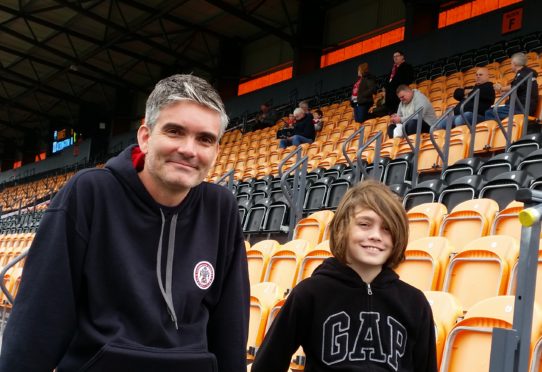Wrapped in his grandmother’s hand-knitted Salisbury football club scarf and standing close to his grandfather at Victoria Park amidst a sea of supporters rippling with waves of excitement, a young boy is in awe of the passion of local football.
Fast-forward four decades,and venture over 600 miles north, and Mat Guy is still struck with that same feeling as he attends Highland League games.
Despite the author residing in Southampton, he has dedicated a year to travelling around the north of Scotland for his new book, ‘Barcelona to Buckie Thistle’.
Spending many of his Saturday afternoons at football parks across Moray, Aberdeenshire and the Highlands watching their small-town teams, Mr Guy learned of the rich heritage of the 126-year-old league from the communities themselves by standing among the dedicated local supporters.
He said: “The feeling I got every time I went to a match was one of overwhelming passion.
“It may be a remote league but it’s not missing the blood and thunder of the game and so this book really is a celebration of the Highland League.”
A long-time football enthusiast with a passion for watching teams from all levels, the author was introduced to Britain’s most northerly senior football championship after discovering his family ties to the region.
From learning that his grandmother lived in towns throughout the north-east area as a teenager during the Second World War, to becoming enthralled by the “unique culture” of the Highland league, he says it married up to be a “no-brainer” to write the book.
He says he called the book ‘Barcelona to Buckie’ to show the parallels he found throughout European nations of smaller leagues being dismissed or overlooked, as the Highland League often is.
Mr Guy said: “There’s no difference to me – whether it’s the world’s biggest team Barcelona or the league’s Buckie Thistle, the passion and the pride of football remains the same.
“It’s just the number of supporters, the scale of grounds and the size of the trophy cabinet that’s different.”
As well as being moved by the unwavering fervour and fierce identity of the Highland League’s 17 teams, Mr Guy was taken aback by the united community spirit.
He commended the supportive nature but “healthy rivalry” between the clubs.
He added: “Of course people want to win, but it’s done with a sporting, cultural and community respect.”
Sam Lees, a life-long follower of Fort William who has been involved in the running of the club for three years, said: “The bond between the clubs in the league is great and you’re always guaranteed first-class treatment by the officials of other clubs when visiting their grounds.
“We try and replicate that for anyone visiting us at Claggan.”
Just as his grandfather passed on his love of the game with him, Mr Guy recognises the importance of the Highland League’s long-embedded roots in generations of families within the communities.
He believes it is crucial that smaller leagues, such as the north’s, continue for many more years to come.
“I hope that people take away from the book how important this league is to the communities it serves and that it’s worth a trip up north to go along one Saturday to support these teams,” he said.
“They are the lifeblood of football.”
The highs of the Highland League
The Highland Football League was formed at the Inverness Workman’s club on August 4, 1893, and initially comprised eight teams.
Despite initial difficulties, which forced one of the teams to drop out, Inverness Thistle were crowned the inaugural champions on February 7, 1894.
In 1954, Buckie Thistle became the first and last non-league side to win a competitive match against a league team at Hampden Park, where they beat Queens Park.
Then, in January 1959, Fraserburgh beat Dundee 1-0 in the Scottish Cup in one of the biggest shocks of all time.
Dundee became Scottish champions just three years later.
Inverness Caledonian Thistle – formed through a merger of Inverness Thistle and Inverness Caledonian – and Ross County were elected to the Scottish Football League in 1994 – both sides reached the top flight within 18 years.
As of the end of 2018’s season, Cove Rangers became the first Highland League club to be awarded promotion to the Scottish Professional Football League, after defeating Berwick Rangers 7-0 on aggregate following a two-legged playoff.
Brora Rangers – among the favourites to win the title this year – began 2019 in fine form and equalled the Highland League record as they reached the fifth round of the Scottish Cup.
Earlier this season, Fort William were victorious over Clachnacuddin to end a two-year spell without a league win.
Clachnacuddin are the proud holders of the record for the most league titles, with 18 in total.
